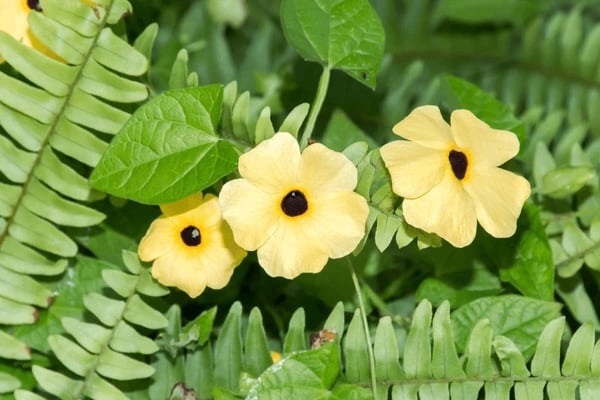Unveiling the Enchanting Black-Eyed Susan Vine: Origin, Features, and Care Tips
The Black-Eyed Susan Vine, a distinctive climbing plant native to the African continent, is predominantly found in tropical and subtropical regions such as South Africa, Zimbabwe, Mozambique, and Malawi. This captivating vine has made its way across the globe, including Vietnam, captivating gardeners and nature enthusiasts alike.
The name “Black-Eyed Susan” is derived from the unique appearance of its flowers, each boasting a dark center that resembles an eye. This vine is a vigorous climber, capable of reaching heights of 3-4 meters, and effortlessly twining around arbors, walls, or fences.
Its leaves are shaped like hearts, showcasing a deep green hue with a soft and glossy texture. The true stars of this plant, however, are its vibrant flowers that bloom in a stunning array of yellow, orange, and white hues. Each flower proudly displays its dark center, creating a striking contrast. The Black-Eyed Susan Vine puts on its most spectacular display during the summer and autumn months when it blooms profusely.

The vibrant flowers of the Black-Eyed Susan Vine come in a stunning array of yellow, orange, and white hues.
Important Considerations for Growing and Caring for Your Black-Eyed Susan Vine
The Black-Eyed Susan Vine thrives in nutrient-rich, well-drained soil and relishes in sunny spots. It is crucial to provide a structure or trellis for the vine to climb, ensuring its healthy growth and development.
Here are some essential factors to keep in mind when cultivating this enchanting plant:
Light
Ensuring that your Black-Eyed Susan Vine receives ample sunlight is of utmost importance. Aim for at least 6 hours of direct sunlight daily to promote vigorous growth and allow it to reach its full potential. However, in regions with hot and dry climates, consider providing partial shade during the hottest afternoon hours to protect the plant from excessive heat and reduce water loss, thus creating optimal conditions for this climber.
Soil
Black-Eyed Susan Vines favor well-drained soil that is rich in organic matter. The ideal pH level for this plant falls within the neutral range of 6.6 to 7.7. To give your vine the best possible start, incorporate some compost into the soil before planting. This not only provides essential nutrients but also improves soil structure, setting the stage for robust growth.

Black-Eyed Susan Vines prefer well-drained, organic-rich soil for optimal growth.
Water
While the Black-Eyed Susan Vine does not tolerate waterlogged soil, it also does not fare well in excessively dry conditions. Maintaining moderate moisture in the soil is crucial. To keep the roots cool and moist, apply a layer of organic mulch around the base of the plant. If your vine is outdoors, adjust your watering schedule according to the current weather conditions. For potted plants, once-a-week watering is usually sufficient.
During hot and dry spells, increase the frequency of watering, especially if the top 2 inches or so of the soil show signs of dryness.
Temperature and Humidity
The Black-Eyed Susan Vine is a perennial plant that typically thrives in warm regions and is grown as an annual in many other areas. When grown indoors, it can bloom during the winter months if provided with sufficient sunlight and temperatures above 15°C.
While humidity is usually not a limiting factor for this plant’s growth, it may struggle in arid conditions. Therefore, maintaining moist soil is essential to ensure the vine’s overall health.

The Black-Eyed Susan Vine is a perennial plant that adds a touch of tropical charm to any garden or indoor space.
Fertilizer
The Black-Eyed Susan Vine is a rapid grower and continuous bloomer throughout the summer, requiring a significant amount of nutrients to sustain this energetic performance. For optimal growth, fertilize your vine regularly every 4 to 6 weeks. For potted plants, whether indoors or outdoors, fertilize every two to three weeks during their blooming period. This will keep your vine healthy and vibrant.
Common Pests
This ornamental vine is generally problem-free, especially when provided with adequate light, moisture, and good air circulation. However, keep an eye out for pests such as mealybugs and spider mites, which can become a nuisance during hot weather or when the plant is brought indoors to a dry environment.
Gardeners should remain vigilant for signs of these tiny insects on the plant, along with any damage to leaves and stems. To safeguard the health of your vine, promptly address any infestations with insecticidal soap.
Encouraging Blooming
The Black-Eyed Susan Vine is a prolific bloomer from late spring (May) through autumn, given the right care. To ensure continuous blooming, adequate light, moisture, and periodic fertilizing are key. These factors not only promote healthy growth but also stimulate flowering.
If you’re captivated by this enchanting vine, why not try your hand at growing a Black-Eyed Susan Vine and witness its beauty unfold each day?
What Does Chu Pa Pi Mo Nha Nho Mean?
“You’ve likely stumbled upon the intriguing phrase, ‘Chu pa pi mô nha nhố.’ But what does it truly mean? Unravel the mystery behind these captivating words and embark on a journey of discovery. Prepare to be enthralled as we explore the essence of this captivating phrase and reveal its hidden depths. Stay tuned and embrace the adventure that awaits!”
The Ultimate Guide to Labrador Retrievers: History, Characteristics, Care, and Pricing
The Labrador Retriever, or ‘Lab’ as they are affectionately known, is a beloved breed of dog renowned for their friendly, devoted, and hardworking nature. With a reputation for being gentle and amiable, Labs have become a popular choice for those seeking a loyal four-legged companion. If you’re considering welcoming a Lab into your home, join us as we delve into the origins, unique characteristics, and care requirements of this wonderful breed.



































